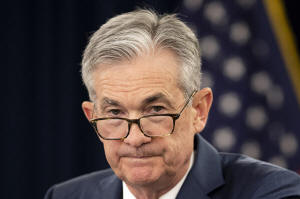Why Trump's call for the Fed to cut interest rates may not help
consumers
[April 26, 2025] By
CHRISTOPHER RUGABER
President Donald Trump is badgering the Federal Reserve to cut interest
rates, but even if the Fed gave in to the pressure, it wouldn't
necessarily lead to lower borrowing costs for consumers.
In fact, economists say, Trump's ongoing attacks on Fed Chair Jerome
Powell and his tariff policies could keep the longer-term interest rates
that matter for consumers and businesses higher than they otherwise
would be. A less-independent Fed can lead, over time, to higher
borrowing costs, as investors worry that inflation may spike in the
future. As a result they demand higher yields to own Treasury
securities.
Trump has repeatedly urged Powell to cut the short-term interest rate
that the central bank controls. The Fed typically reduces its rate
during an economic downturn to encourage more borrowing and spending,
and raises it to cool the economy and fight inflation when prices rise.
But long-term rates on things like mortgages, auto loans, and credit
cards are largely set by market forces. And in recent weeks, fears that
Trump's sweeping tariffs could raise inflation, along with the
administration's threats to the Fed's independence, have led markets to
push those longer term rates higher. It's not clear that the Fed can
fully reverse those trends by itself.
“It’s not automatically true that even if the Fed were to cut rates,
that you would see a measured decline in long-term interest rates,”
Francesco Bianchi, an economist at Johns Hopkins University, said. “This
kind of pressure on the Fed might backfire...if markets don't believe
the Fed has inflation under control."
Trump renewed calls on Wednesday and Thursday for Powell to reduce the
Fed's short-term rate, telling reporters that the chair is “making a
mistake” by not doing so.
And last week, Trump suggested he could fire Powell, while a top aide
said that the White House was “studying” whether it could do so.
Stock markets plunged in response, the yield on the 10-year Treasury
bond rose, and the dollar fell, an unusual combination that suggested
investors were selling most American assets. Markets recovered those
losses after Trump said on Tuesday that he had “no intention” of firing
the Fed chair.

Still, the threats to the Fed's independence unnerved Wall Street
investors, because they see a Fed free from political pressure as
critical to keeping inflation in check. An independent Fed can take
unpopular steps, such as raising rates, to fight inflation.
“Threatening the Fed doesn’t soothe markets — it spooks them,” said
Lauren Goodwin, chief market strategist at New York Life Investments.
“And the result is often the opposite of what any administration wants
to see: higher rates, weaker confidence, and more market turmoil.”
Since Trump began imposing tariffs in early March, when he slapped
duties on Canada and Mexico, the 10-year Treasury yield has risen from
4.15% to about 4.3%. The yield is a benchmark for mortgage rates and
other borrowing. Mortgage rates, in turn, have increased during that
time, from 6.6% to 6.8%.

While Trump says he is negotiating over tariffs with many countries,
most economists expect some level of duties to remain in place for at
least this year, including his 10% duties on nearly all imports.
The 10-year yield did fall Thursday when two Federal Reserve officials
said that rate cuts are possible as soon as this summer, should the
economy falter and unemployment rise.
[to top of second column] |

In this July 31, 2019, file photo, Federal Reserve Chairman Jerome
Powell speaks during a news conference following a two-day Federal
Open Market Committee meeting in Washington. (AP Photo/Manuel Balce
Ceneta, File)
 Yet last fall, longer-term interest
rates also fell in anticipation of rate cuts, but then rose once the
Fed cut in September and then continued to rise as the central bank
reduced its rate again in November — two days after the election —
and in December. Mortgage rates are now higher than they were when
the Fed cut.
A range of factors can affect longer-term Treasury rates, including
expectations for future growth and inflation, as well as the supply
and demand for government bonds. Bianchi worries that stubbornly
high government budget deficits — which are financed by trillions of
dollars of Treasurys — could also lift long-term rates.
Should the Fed cut rates now, llonger-term borrowing costs “would
move in the opposite direction, absolutely,” Goodwin said, “because
the threat of inflation is so palpable -- that move would call their
credibility into question."
Trump said in a social media post this week that there is “virtually
No Inflation” and as a result, the Fed should lower its key rate,
from its current level of about 4.3%. Many economists expect the
central bank will do so this year. But Powell has underscored that
the central bank wants to evaluate the impact of Trump's policies
before making any moves.
Inflation has fallen in recent months, dropping to 2.4% in March,
the lowest level since last September. Yet excluding the volatile
food and energy categories, core inflation was 2.8%. Core prices
often provide a better signal of where inflation is headed.
A key issue for the Fed is that the economy is very different now
than it was during Trump's first term. Back then inflation was
actually below the Fed's target. At that time, it was a “no-brainer”
to cut rates, Bianchi said, if there was a threat of a recession,
because inflation wasn't an issue.
But now, tariffs will almost certainly lift prices in the coming
months, at least temporarily. That raises the bar much higher for a
Fed rate cut, Bianchi said.
Still, once there are clear signs the economy is deteriorating, such
as a rising unemployment rate, the Fed will cut rates, regardless of
what Trump does, economists said.
Trump on Monday accused Powell of often being “too late” with his
rate decisions, but ironically the Fed may move more slowly this
time because of the threat of higher prices from tariffs. Without
clear evidence of a downturn, Fed officials would worry about being
seen as giving in to political pressure from Trump if they cut.
“Powell knows the irreparable damage that would occur if it was
perceived that he cut because he was forced to by Trump,” said Tom
Porcelli, chief U.S. economist at PGIM Fixed Income.
The Fed now “will be even more delayed because I think you’re going
get more of an inflation lift initially, before you get the more
pronounced slowing in growth," Porcelli said.
Either way it may take more than a Fed cut or two to bring down
longer-term borrowing costs, Bianchi said.
“To really lower long-term rates you need to provide a stable
macroeconomic environment, and right now we are not there yet," he
added.
All contents © copyright 2025 Associated Press. All rights reserved |